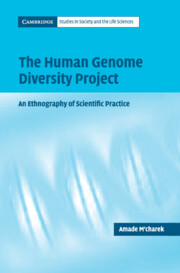Book contents
- Frontmatter
- Contents
- Preface
- 1 Introduction
- 2 Technologies of population: making differences and similarities between Turkish and Dutch males
- 3 Ten chimpanzees in a laboratory: how a human genetic marker may become a good genetic marker for typing chimpanzees
- 4 Naturalization of a reference sequence: Anderson or the mitochondrial Eve of modern genetics
- 5 The traffic in males and other stories on the enactment of the sexes in studies of genetic lineage
- 6 Technologies of similarities and differences, or how to do politics with DNA
- Glossary
- References
- Index
2 - Technologies of population: making differences and similarities between Turkish and Dutch males
Published online by Cambridge University Press: 06 July 2010
- Frontmatter
- Contents
- Preface
- 1 Introduction
- 2 Technologies of population: making differences and similarities between Turkish and Dutch males
- 3 Ten chimpanzees in a laboratory: how a human genetic marker may become a good genetic marker for typing chimpanzees
- 4 Naturalization of a reference sequence: Anderson or the mitochondrial Eve of modern genetics
- 5 The traffic in males and other stories on the enactment of the sexes in studies of genetic lineage
- 6 Technologies of similarities and differences, or how to do politics with DNA
- Glossary
- References
- Index
Summary
Introducing the argument
This chapter is about population. It will attempt to answer the question: “What is population?” Instead of defining it myself or asking geneticists what it is, I want to trace population in genetic practices. I will, therefore, examine how it is enacted in them. To do this, I will analyze a forensic DNA case starting with the basic court case and then discussing the subsequent stages of the case and of the DNA evidence provided. My analysis results in two arguments: first, that geneticists cannot know the individual without a population; second, that in genetics neither the individual nor the population are inherently “biological.” Rather, they are effects of technologies and routines applied in scientific practice.
As has been discussed in Chapter 1, population is a subject of debate in the Diversity Project. In order to sample, study and compare populations, geneticists aim at achieving a consensus definition of what population is. This chapter, however, examines practices of population in laboratory routines and reveals different versions of what population is made to be in such locales. In order to know a population, geneticists study cell material from collections of individuals. In forensic science, however, the vantage point is quite different. Forensic geneticists are interested in the individual. Their aim is to identify individual A as similar to or different from individual B. Yet I have chosen this very practice as a site for examining population, for in order to know an individual, forensic geneticists also apply a category of population.
- Type
- Chapter
- Information
- The Human Genome Diversity ProjectAn Ethnography of Scientific Practice, pp. 21 - 55Publisher: Cambridge University PressPrint publication year: 2005
- 1
- Cited by

